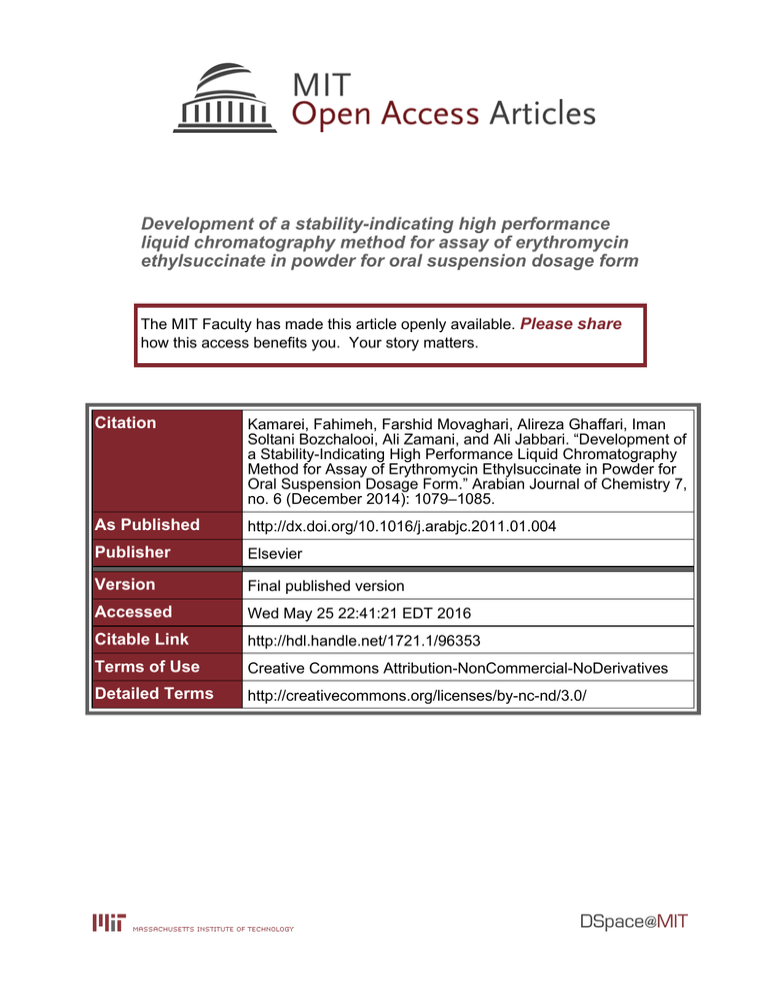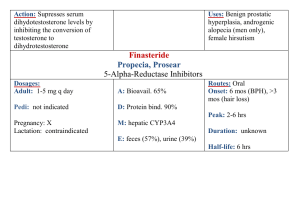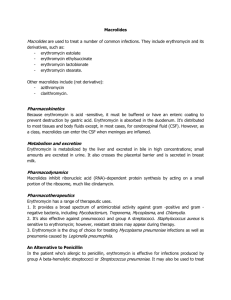Development of a stability-indicating high performance
advertisement

Development of a stability-indicating high performance liquid chromatography method for assay of erythromycin ethylsuccinate in powder for oral suspension dosage form The MIT Faculty has made this article openly available. Please share how this access benefits you. Your story matters. Citation Kamarei, Fahimeh, Farshid Movaghari, Alireza Ghaffari, Iman Soltani Bozchalooi, Ali Zamani, and Ali Jabbari. “Development of a Stability-Indicating High Performance Liquid Chromatography Method for Assay of Erythromycin Ethylsuccinate in Powder for Oral Suspension Dosage Form.” Arabian Journal of Chemistry 7, no. 6 (December 2014): 1079–1085. As Published http://dx.doi.org/10.1016/j.arabjc.2011.01.004 Publisher Elsevier Version Final published version Accessed Wed May 25 22:41:21 EDT 2016 Citable Link http://hdl.handle.net/1721.1/96353 Terms of Use Creative Commons Attribution-NonCommercial-NoDerivatives Detailed Terms http://creativecommons.org/licenses/by-nc-nd/3.0/ Arabian Journal of Chemistry (2011) xxx, xxx–xxx King Saud University Arabian Journal of Chemistry www.ksu.edu.sa www.sciencedirect.com ORIGINAL ARTICLE Development of a stability-indicating high performance liquid chromatography method for assay of erythromycin ethylsuccinate in powder for oral suspension dosage form Fahimeh Kamarei a,b,*, Farshid Movaghari a, Alireza Ghaffari Iman Soltani Bozchalooi d, Ali Zamani a, Ali Jabbari a a,c , a Pharmaceutical R&D Department, Chemi Darou Industrial Co., Tehran, Iran Department of Chemistry, Shahid Beheshti University, G.C., Evin, Tehran, Iran c Department of Pharmaceutics, Islamic Azad University, Pharmaceutical Sciences Branch, Tehran, Iran d Department of Mechanical Engineering, Massachusetts Institute of Technology, 77 Massachusetts Ave., Cambridge, MA 02139, USA b Received 7 December 2010; accepted 5 January 2011 KEYWORDS Stability-indicating; Erythromycin ethylsuccinate; Oral suspension; Pharmaceutical forms; High performance liquid chromatography Abstract In this study an effective method was developed to assay erythromycin ethylsuccinate for an oral suspension dosage form. The chromatographic separation was achieved on an X-Terra C18 analytical column. A mixture of acetonitrile–ammonium dihydrogen phosphate buffer (0.025 mol L-1) (60:40, V/V) (pH 7.0) was used as the mobile phase, effluent flow rate monitored at 1.0 mL min1, and UV detection at 205 nm. In forced degradation studies, the effects of acid, base, oxidation, UV light and temperature were investigated showing no interference in the peak of drug. The proposed method was validated in terms of specificity, linearity, robustness, precision and accuracy. The method was linear at concentrations ranging from 400 to 600 lg mL1, precise (intra- and inter-day relative standard deviations <0.65), accurate (mean recovery; 99.5%). The impurities and degradation products of erythromycin ethylsuccinate were selectively determined with good resolution in both the raw material and the final suspension forms. The method could * Corresponding author at: Pharmaceutical R&D Department, Chemi Darou Industrial Co., Tehran, Iran. Tel.: +98 21 77330300. E-mail address: f_kamarei@sbu.ac.ir (F. Kamarei). 1878-5352 ª 2011 King Saud University. Production and hosting by Elsevier B.V. All rights reserved. Peer review under responsibility of King Saud University. doi:10.1016/j.arabjc.2011.01.004 Production and hosting by Elsevier Please cite this article in press as: Kamarei, F. et al., Development of a stability-indicating high performance liquid chromatography method for assay of erythromycin ethylsuccinate in powder for oral suspension dosage form. Arabian Journal of Chemistry (2011), doi:10.1016/j.arabjc.2011.01.004 2 F. Kamarei et al. be useful for both routine analytical and quality control assays of erythromycin ethylsuccinate in commercial powder for an oral suspension dosage form and it could be a very powerful tool to investigate the chemical stability of erythromycin ethylsuccinate. ª 2011 King Saud University. Production and hosting by Elsevier B.V. All rights reserved. 1. Introduction Erythromycin is produced by a strain of Streptomyces erythraeus and belongs to the macrolide group of antibiotics. It is basic and readily forms salts with acids. Erythromycin is an antibiotic that prevents protein synthesis at bacterial ribosomes, resulting in the death of the organism. Erythromycin is used for the treatment of pneumonias, streptococcal pharyngitis, skin infections and erythrasma. However, erythromycin is a basic compound which is degraded to inactive anhydrous erythromycin in acidic fluids. Hence, ester type prodrugs are preferred and used for oral administration (Bryskier et al., 1993). Erythromycin ethylsuccinate (EES), a prodrug of erythromycin, belongs to macrolide antibiotics (Fig. 1) and EES is antibacterially inactive and only becomes effective after it is hydrolyzed to erythromycin in plasma and other body fluids (Kokkonen et al., 1991). EES has been formulated in both liquid and solid dosage forms for oral administration. EES is hydrolyzed in aqueous solutions (Steffansson and Bundgaard, 1989), therefore, commercial products are formulated as powder or granulate forms for reconstitution. EES is absorbed intact and hydrolyzed in the circulating blood to the active form (Deicke and Süverkrüp, 2000). At present, official methods of the United States and British Pharmacopeia for assay determination of EES in powder for oral suspension dosage form involve the use of a microbiological method (USP, 2009; British Pharmacopoeia, 2009). The stability indicating method is a method that identifies the degradation products of analytes (Vaucher et al., 2009). Since the microbiological assay is not stability-indicating (Croteau et al., 1987), the presence of erythromycin base and any related degradation products in raw material or dosage forms of EES cannot be established. Literature survey reveals several analytical methods for the determination of EES in pharmaceutical preparation and biological fluids. These methods are chromatographic techniques, such as; HPLC–ECD (Croteau et al., 1987), HPLC–UV (Cachet et al., 1992; Wardrop et al., 2000; Nasr and Stanley, 1998; Chepkwony et al., 2000) as well as HPLC–MS (Gu et al., 2006). In the present research a very simple and rapid isocratic RP-HPLC method which can be used for the routine analysis of EES for oral suspension was developed. The proposed method was validated with respect to specificity, linearity, precision, accuracy and robustness. In addition, stress testing of the drug was also conducted, as required by the International Conference on Harmonization (ICH, 2003) to support the suitability of the method. 2. Experimental 2.1. Reagents Reference standards of erythromycin ethylsuccinate (with minimum purity of 84.05%) were purchased from Anuh pharma Ltd. (Mumbai, India). Erythromycin base containing (93.5% erythromycin A), erythromycin B and erythromycin C were used throughout the study. Ammonium dihydrogen phosphate, sodium hydroxide and HPLC grade acetonitrile were purchased from Merck (Darmstadt, Germany). Ultrapure water was prepared using a Milli-Q system from Millipore (Bedford, MA, USA). 2.2. Powder for oral suspension Three different commercially available products of EES for oral suspension with nominal potencies of about 200 mg erythromycin (as erythromycin ethylsuccinate) per 5 mL from Hexal AG (Holzkirchen, Germany), Loghman Pharmaceutical and Hygienic Co. (Tehran, Iran) and Chemi darou Industrial Co. (Tehran, Iran) were used in this study. 2.3. Instrumentation and chromatographic condition Figure 1 Chemical structure of erythromycin ethylsuccinate. Injection of the samples into high performance liquid chromatography (HPLC) was carried out using a 100-lL Hamilton (Bonaduz, Switzerland). Separation and quantification of analytes were performed using the Agilent (Wilmington, DE, USA) 1200 series, consisting of a Rheodyne 77251 injector (Cotati, CA, USA) equipped with a 100-lL sample loop, a diode array detector 1200 series, monitoring at 205 nm. The instrument was linked to HP ChemStation software. An XTerra C18 column (250 · 4.6 mm I.D., 5 lm) from Waters (Dublin, Ireland) was employed at an ambient temperature. A mixture of acetonitrile and 0.025 mol L1 ammonium dihydrogen phosphate buffer at a ratio of (60:40 V/V), (pH 7.0) was used in this study. The apparent pH was also adjusted to 7.0 with 10% (W/V) sodium hydroxide solution. The flow rate of the mobile phase was 1 mL min1. Please cite this article in press as: Kamarei, F. et al., Development of a stability-indicating high performance liquid chromatography method for assay of erythromycin ethylsuccinate in powder for oral suspension dosage form. Arabian Journal of Chemistry (2011), doi:10.1016/j.arabjc.2011.01.004 Development of a stability-indicating high performance liquid chromatography method for assay of erythromycin 3 Figure 2 Chromatogram of a synthetic mixture of (1) erythromycin C, (2) erythromycin A, (3) erythromycin B, (4) erythromycin ethylsuccinate. Experimental condition: ammonium dihydrogen phosphate buffer: acetonitrile (40:60), pH 7.0; UV detection: 205 nm; flow rate: 1.0 mLmin1. 2.4. Preparation of standard and sample solutions 2.4.1. Standard preparation The working standard solution of erythromycin ethylsuccinate (500 lg mL1) was prepared in a volumetric flask by dissolving EES in a small portion of acetonitrile, and then diluting with the mobile phase to volume. The known potential impurities were also added in the standard solution for the purity test of bulk drug. 2.4.2. Sample preparation A portion of the powder for oral suspension equivalent to 50 mg of EES was weighed and transferred into a 100-mL volumetric flask. Then 20 mL of acetonitrile was added. The mixture was then sonicated for 5 min, and adjusted to volume with mobile phase and mixed well. 2.4.3. Degradation study EES at a concentration of 2000 lg mL1 was used in all the degradation studies. The samples were exposed to stress conditions in 0.1 N HCl, 0.1 N NaOH and 3% (W/V) H2O2. After the completion of the process, the solutions were diluted at the ratio of 1:4 with mobile phase. In order to examine thermal and photo degradation processes, the commercial powder for oral suspension was exposed to 70 C and daylight fluorescent lamp conditions. Following the completion of the process, samples were prepared as described in the previous section. 3. Results and discussion 3.1. Optimization of the HPLC condition The chromatographic conditions were optimized with respect to resolution, specificity and analysis duration. Acceptable separations were obtained using an X-Terra C18 (250 · 4.6 mm I.D., 5 lm) column. The effects of pH (5.5–7.5), ionic strength (0.025–0.05 mol L1) and different mobile phase ratio were investigated using an ammonium dihydrogen phosphate buffer. The best result in terms of peak symmetry, resolution and retention time was obtained using acetonitrile:buffer (60:40), as mobile phase. In this case the buffer of mobile phase was 0.025 mol L1 of ammonium dihydrogen phosphate and the final pH of the mobile phase was also adjusted to 7.0 with 10% (W/V) sodium hydroxide solution. In fact, at lower pH (<5.5) the peak symmetry of the EES was severely affected on most of the higher loaded stationary phases and fronting was observed. On the other hand, higher pH (>7.5) was not considered in the experiments as it lowers the stability of the stationary phase. Therefore, pH 7.0 was adopted in subsequent experiments. The detection was carried out at 205 nm. In the optimized conditions described above, EES was well separated from the main hydrolysis product, erythromycin A as well as minor impurities (erythromycin B and erythromycin C) in samples. Fig. 2 shows a typical chromatogram of a synthetic mixture of the four mentioned compounds. 3.2. Degradation of EES The capability of stability-indicating assay was examined through stress testing. Standards, samples and placebo were subjected to the following conditions: acidic, basic and oxidative degradation using 0.1 N HCl, 0.1 N NaOH and 3% H2O2, respectively. For the thermal and photo degradation, 70oC and daylight fluorescent lamp radiance were applied, respectively. In acidic, basic and oxidative degradation processes 2000 lg mL1 of EES was prepared in aforementioned solution for 4 h at 25 C, and then the solutions were diluted at 1:4 ratio with mobile phase. Finally, 100 lL of the obtained solutions was injected into the HPLC system for subsequent analysis. Fig. 3A shows the chromatogram of EES working standard (500 lg mL1) and Fig. 3B–D show the chromato- Please cite this article in press as: Kamarei, F. et al., Development of a stability-indicating high performance liquid chromatography method for assay of erythromycin ethylsuccinate in powder for oral suspension dosage form. Arabian Journal of Chemistry (2011), doi:10.1016/j.arabjc.2011.01.004 4 F. Kamarei et al. Figure 3 Chromatograms of (A) working standard of EES (500 lg mL1), (B) acid hydrolysis-degraded, (C) base hydrolysis-degraded, (D) oxidative-degraded. Experimental condition: ammonium dihydrogen phosphate buffer: acetonitrile (40:60), pH 7.0; UV detection: 205 nm; flow rate: 1.0 mL min1. grams of the EES in acidic, basic and oxidative stress conditions, respectively. Fig. 4A shows the chromatogram of the sample (500 lg mL1) before exposure to the thermal and photo degradation conditions. In order to investigate the thermal degradation of sample, a small portion of commercial samples of powder for oral suspension were kept at 70 C for 4 h. Photo degradation was performed as well for the same samples by exposing them to daylight fluorescent lamp radiation for 24 h at 25 C. The results showed that the degradation rate of these products were slowly in initial hours (Fig. 4B and C). The placebo was submitted to the same degradation conditions in order to demonstrate no interference. All degradation studies showed that the degradation products were well sepa- rated from EES peak, confirming the stability indicating capability of the method. 3.3. Stability of EES in solution The stability of EES in mobile phase was investigated by analyzing the standard of EES (500 lg mL1) containing 500 lg mL1 of erythromycin A (internal standard) at 0, 15, 30, 45, 60, 90, 120 and 140 min, after preparation at ambient temperature. Fig. 5 shows that after 120 min, the areas of peaks decreased. This can be explained by the fact that the hydrolysis of EES is time dependent. Therefore, the working standard should be used freshly. Please cite this article in press as: Kamarei, F. et al., Development of a stability-indicating high performance liquid chromatography method for assay of erythromycin ethylsuccinate in powder for oral suspension dosage form. Arabian Journal of Chemistry (2011), doi:10.1016/j.arabjc.2011.01.004 Development of a stability-indicating high performance liquid chromatography method for assay of erythromycin 5 Figure 4 Chromatogram of (A) sample (hexal) (500 lg mL1), (B) thermal-degraded, (C) photo-degraded. Experimental condition: ammonium dihydrogen phosphate buffer: acetonitrile (40:60), pH: 7.0; UV detection: 205 nm; flow rate: 1.0 mL min1. 3.4. Validation of assay method The proposed method was further validated for specificity, linearity, accuracy, precision, robustness and system suitability according to ICH guidelines (ICH, 1995). 3.4.1. Specificity The specificity of the analytical method was determined by comparing the results from an analysis of samples containing impurities, degradation products, or excipients with those obtained from samples without the above mentioned cases. As can be seen in the chromatograms of degradation studies, all degradation products were separated from EES peak. In order to confirm this result, a given portion of placebo was prepared in mobile phase and injected onto the chromatograph. Results indicate that excipients have no interference with EES. The homogeneity and peak purity of the EES peak in three expired product samples were estimated based on a photodiode-array (PDA) scan from 210 to 400 nm. Peak purity factor was Please cite this article in press as: Kamarei, F. et al., Development of a stability-indicating high performance liquid chromatography method for assay of erythromycin ethylsuccinate in powder for oral suspension dosage form. Arabian Journal of Chemistry (2011), doi:10.1016/j.arabjc.2011.01.004 6 F. Kamarei et al. 1.590 1.570 Relative area 1.550 1.530 1.510 1.490 1.470 1.450 0 15 30 45 60 75 90 105 120 135 150 Time (min) Figure 5 Profile of EES stability in mobile phase. Experimental condition: ammonium dihydrogen phosphate buffer: acetonitrile (40:60), pH: 7.0; UV detection: 205 nm; flow rate: 1.0 mL min1. Table 1 Figures of merit of the proposed method. DLR (lg mL1) Regression equation r2 Table 2 Accuracy assessment of the proposed method for EES assay. 400–600 Y = 18.65aX 424b 0.9930 Working standard range (%) Cadded (lg mL1) % Recoverya SDa a b SD and RSD of slope; 0.156, 0.85. SD and RSD of intercept; 2.98, 1.46. 80 100 120 400 500 600 99.50 99.84 99.89 0.381 0.141 0.202 a obtained which was 995.045 and Purity threshold calculated by PDA software automatically which was 997.692. 3.4.2. Linearity Linearity of system was evaluated by the analysis of three replicates of five concentrations of standard solutions (ranging from 400 to 600 lg mL1). Linear dynamic range (LDR), regression equation and correlation coefficient (r2) are given in Table 1. 3.4.3. Accuracy In order to evaluate the recovery of analyte, accuracy study was performed by spiking three known amounts of EES in placebo suspension (ranging from 80% to 120% working standard concentration, 500 lg mL1). Three samples were prepared at each of these concentrations. The recovery of added drug was calculated by comparing the area of EES peak of the test sample with that of the standard solution. The results are given in Table 2. 3.4.4. Precision Precision of an analytical procedure expresses the closeness of agreement between a series of measurements obtained from multiple samples. The precision is usually investigated at three levels: repeatability, intermediate precision and reproducibility (Chan et al., 2004). The repeatability (intraday) and reproducibility (interday) were studied based on the peak area at 500 lg mL1 concentration by injecting five samples onto the chromatograph. The precisions of 0.64 and 0.65 were obtained for intra and inter day, respectively. Standard deviation (SD) and % recovery were obtained at mean value of four replicate measurements. Table 3 System suitability parameters. Parameter EES Preferable levels K0 A Rs N As 3 1.21 1.86 2560 0.97 2–5 1.0–2.0 >1.5 >2500 <1.5 Table 4 HPLC assay results of commercial EEs powder for oral suspension. Product testeda USP assay Label claim (mg/5 mL) % Found ± SD limitb % Hexal Loghman Chemi darou a b 90–120 90–120 90–120 200 200 200 97.43 ± 0.76 94.76 ± 0.52 95.91 ± 0.43 Samples were prepared as described in Section 2. USP (2009). 3.4.5. Robustness The robustness of an analytical procedure is a measure of its capacity to remain unaffected by small but deliberate variations in the analytical procedure parameters. The robustness Please cite this article in press as: Kamarei, F. et al., Development of a stability-indicating high performance liquid chromatography method for assay of erythromycin ethylsuccinate in powder for oral suspension dosage form. Arabian Journal of Chemistry (2011), doi:10.1016/j.arabjc.2011.01.004 Development of a stability-indicating high performance liquid chromatography method for assay of erythromycin of an analytical procedure provides an indication of its reliability during normal use (Chan et al., 2004). The robustness of proposed method was evaluated by keeping chromatographic conditions constant while the following differences were incorporated into experiments: 1) Changing ammonium dihydrogen phosphate buffer (35%, V/V) and acetonitrile (65%, V/V) composition in mobile phase. 2) Increasing the flow rate of mobile phase from 1.0 to 1.5 mL min1. 3) Using another column (Agilent, C18, 250 · 4.6 mm I.D., 5 lm), standard solution was injected six times in replicate for each change. All the parameters of system suitability were recorded and found to be within acceptable limits. Recoveries and relative standard deviations were calculated for EES during each change and found to be 99.5–99.99% and <1.0%, respectively. 3.4.6. System suitability The system suitability parameters including asymmetric factor (As), resolution (Rs), selectivity (a) and capacity factor (K), listed in Table 3, were obtained by six replicates. All parameters were acceptable with good specificity for the stability assessment of EES. 3.4.7. Assay of EES in powder for oral suspension Three different commercially available powder products for oral suspension were obtained and assayed as described in Section 2. The assay results of EES for oral suspension dosage forms were comparable with the label value claimed. The results are shown in Table 4. 4. Conclusion Proposed isocratic RP-HPLC method can be used as a stability indicating assay as well as for the potency assay of EES for oral suspensions. This method offers the separation of EES from related substances, impurities and degradation products simultaneously. The most important advantage of the proposed method in comparison with pharmacopeia (USP, 2009; British Pharmacopoeia, 2009) is using a specific chromatographic method. Proposed method can be replaced by a tedious, time-consuming and non-specific microbiological assay method (Bioassay). The method has been validated and 7 it has been shown that it is reliable, linear, and precise as well as robust with minor variations in chromatographic parameters. Therefore, it can be applied for both routine analytical and quality control assay of erythromycin ethylsuccinate in commercial powder for oral suspension and it could be a very powerful tool to investigate the chemical stability of erythromycin ethylsuccinate. Acknowledgements The authors wish to thank Dr. A. Mir Mohammad Sadeghi for her assistance in preparation of our paper. This study was supported by the Vice Research of Chemi Darou Industrial Company. References British Pharmacopoeia, Her Majesty’s Stationary Office, London, UK, 2009. Bryskier, A.C., Agouridas, J.C., 1993. In: Macrolides: Chemistry, Pharmacology and Clinical Uses. Blackwell, Paris, 10. Cachet, T., Lannoo, p., Paesen, J., Janssen, G., Hoogmartes, J., 1992. J. Chromatogr. 600, 99. Chan, C.C., Lam, H., Lee, Y.C., Zhang, X.M., 2004. Analytical Method Validation and Instrument Performance Verification. John Wiley & Sons, 18. Chepkwony, H.K., Vanderriest, I., Nguyo, J.M., Roets, E., Hoogmartens, J., 2000. J. Chromatogr. A 870, 227. Croteau, D., Vallee, F., Bergeron, M.G., Lebel, M., 1987. J. Chromatogr. 419, 205. Deicke, A., Süverkrüp, R., 2000. Eur. J. Pharm. Biopharm. 49, 73. Gu, Y., Wang, G., Sun, J., 2006. J. Pharm. Biomed. Anal. 40, 737–743. ICH Q1A (R2), 2003. Stability testing of new drug substances and products. In: Proceedings of the International Conference on Harmonization. ICH Q2 (R1), 1995. Validation of analytical procedures: text and methodology. In: Proceedings of the International Conference on Harmonization. Kokkonen, P.S., Niessen, W.M.A., Tjaden, U.R., van der Greef, J., 1991. J. Chromatogr. 565, 265. Nasr, M.M., Stanley, C.M., 1998. J. Liq. Chromatogr. Relat. Technol. 21, 1147. Steffansson, B., Bundgaard, H., 1989. Int. J. Pharm. 56, 159. US Pharmacopoeia 32, 2009. US Pharmacopeial Convention, Rockville, MD, pp. 2292. Vaucher, L.C., Paim, C.S., Lange, A.D., Schapoval, E.E.S., 2009. Int. J. Pharm. 366, 82. Wardrop, J., Ficker, D., Franklin, S., Gorski, R.J., 2000. J. Pharm. Sci. 89, 1097. Please cite this article in press as: Kamarei, F. et al., Development of a stability-indicating high performance liquid chromatography method for assay of erythromycin ethylsuccinate in powder for oral suspension dosage form. Arabian Journal of Chemistry (2011), doi:10.1016/j.arabjc.2011.01.004




